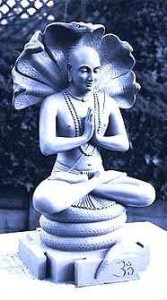
Ashtanga yoga, the yoga of eight components
In school and college, we proceed through a graded series of concepts on our way to mastering a subject: in mathematics, for example, first we learn counting, then addition and subtraction, then multiplication and division, fractions, geometry, algebra, and so on. If you were suddenly dropped into a project involving real analysis, you would likely be very confused.
Eight parallel components, not eight graded steps
Likewise, Patanjali’s Yoga Sutras divide the way of yoga into eight components, which all build upon and reinforce each other. These eight components are grouped under two headings – the bahiranga, or external; the antaranga, or internal. As you read, keep in mind that this division is arbitrary and provisional, and each of these components reinforce all others.
The ethical foundations of Yoga
The external components are a mix of principles as well as practice: on the one hand a yogi follows Yama, prohibitions, and Niyama, commandments to be followed. The yama are five in number, beginning with the old favourite of dhaarmik philosophies, ahinsaa, or not-harming, not just by our actions but also our words and our thoughts. Then comes satya, being true to oneself, followed by brahmacharya, commonly translated as celibacy, but more literally, “divine conduct”. There are two more yama related to material possessions to be followed: asteya, not desiring what is not our own, and aparigraha, being unattached to material possessions.
The niyama are again five in number: shauch, or purity of body and mind; santosh, or contentment, closely aligned with asteya and aparigraha; tapas, that is, effort (note that Vaidik-Patanjali yoga does not advocate ghor tapasya, or mortification); swaadhyaay, which is (mis)translated as reading the scriptures, when literally it means self-study; and eeshwar-pranidhaan, or relying on or surrendering to God.
These are the ethical guidelines of Yoga darshan, the philosophy of yoga. Obviously, as we can see here, the practice of yoga is not just about bending one’s body in weird shapes, or doing breathing exercises till the cows come home. A holistic, classically genuine yoga practice involves extensive application of not just the body but also our mental and moral selves. There have been countless cases of so-called or self-declared yogis who have been masters at teaching aasana practice, especially to western students, and who have later had to face widespread allegations of sexual misconduct or abuse of the psychological power and status they held over their students. One must ask, is this really yoga, and are these really yogis?
Yama and Niyama as milestones on the way
There must be thousands of ballet dancers, thousands of gymnasts and figure skaters and divers who can do aasanas better than most yogis in the world. Does that make them an accomplished yoga master? No. There is a moral foundation, a training of the mind and the will that goes along with the training of the body. These yama and niyama are the underlying foundation on which one can begin to practise the other steps of Yoga darshan, and against which one must consistently evaluate one’s development: if the yoga sadhana we are doing does not make us more naturally compassionate, more naturally non-possessive, more naturally peaceful and content, one must go back and check what we are doing wrong in the sadhana.
What is this sadhana? That’s for upcoming pieces of the vast puzzle of Yoga darshan.
